MRL-Based Model for Diverse Bidding Decision-Makings of Power Retail Company in the Wholesale Electricity Market of China
Abstract
1. Introduction
| Reference | Bidder | MRL-Based | Learning Algorithm | Bidding Objective |
|---|---|---|---|---|
| [3,4,5,6,7,8,9,10,11,12] | GenCo and/or RetCo | No | None | Max. profits |
| [15] | GenCo | Yes | Not mentioned | Max. profits |
| [16,17,18,19,20,23,24,25,26,27] | GenCo/RetCo /microgrids/ distributed energy/ demand | Yes | RE and its variants | Max. profits or min cost |
| [28,29,30] | GenCo | Yes | Q-learning and its variants | Max. profits |
| [31,32,33,34,35,36] | GenCo | Yes | Deep RL | Max. profits |
| proposed | RetCo | Yes | RE | Diverse |
- Propose a model for diverse bidding decision-making among the power retail companies in China’s electricity market. Different from the existing work only considering the profit-maximizing objective, we first build up the mathematical models of diverse bidding decision-making concerning three types of operational objectives and five types of profit-sharing modes, which contribute to a more realistic simulation and modeling of retail companies.
- An MRL-based electricity market simulation model with power retail companies’ diverse bidding decision-making is established to capture individual subjectivity and irrationality in the bidding decision-making, which contributes to a more realistic simulation and modeling of the electricity market.
2. Bidding in Wholesale Electricity Market
2.1. Market Structure
- The impacts of the yearly market and spot market on the monthly market bidding decisions are not considered to simplify the problem formulation, which is commonly applied in most relevant studies.
- The impacts of the trading between the power retail companies and end users are considered when building up the profit-sharing modes. In fact, the direct and indirect impacts from the end user’s side could be complicated, and trading forms differ significantly worldwide, which will all have impacts on the decision-making in the wholesale market. In the U.S., the end users often pay bills to the retail companies through a power purchase agreement (PPA) or electricity retail plan (ERP) [44], but the prices are usually independent of the wholesale market. Different from the U.S., many retail companies and the end users in China have an agreement on how to divide the profit from the wholesale market, which is called the spread rebate mode in [39]. To extend it to a more general model, this paper builds up a mathematical model of the profit-sharing modes.
- The impacts of the energy deviation settlement mechanism (EDS), deviation mutual insurance (DMI), contract transfer market, and intramonth market are not included in this paper. In China’s monthly market, the above mechanisms have been applied in some markets to settle and reduce the deviation between consumption and energy contracts of the retail companies [45] and may have further impacts on the bidding decisions on the wholesale markets. In this paper, these impacts are not considered to simplify the problem formulation.
2.2. Market-Clearing Mechanism
3. Modeling of Diverse Bidding Decision-makings
3.1. Three-Dimension Influencing Factors
- Market share. From the perspective of whether the influences of biddings/offers on clearing prices are considered, a participant in the market can be generally defined as a price-taker or price-maker depending on its market share [53]. If a participant is small-scale and its bidding/offering actions can hardly impact the market clearing price, it is called a price taker. Under the pay-as-clear market mechanism, a price-taker generator often bids the lowest price, i.e., the “floor price”, and the price-taker retail company often bids the highest price, i.e., the “ceil price”, which ensures that the bids/offers can be cleared successfully. On the contrary, price makers will often take more complex bidding strategies in the market bidding. Therefore, we assume that price takers bid at stable prices and that price makers use the MRL algorithm to optimize their bidding decisions.
- Operation objective. The operation objective determines the objective function model in retail company modeling. From a rational point of view, the market participants should maximize the profits, but observations from the real markets seem to not obey this rule. Especially in a newly developing market, e.g., China, power retail companies have diverse operation objectives and often adopt unusual bidding strategies. For example, some retail companies are established by generation power companies. They are well capitalized, would rather lose money to expand sales of electricity, and often fight the price war. Another example is that some retail companies have large enterprises as shareholders, such as Alibaba, and often bid at a high price to guarantee their bids can be cleared, while selling the electricity at a low price to maintain a stable connection with the end users. Through investigation and analysis of the actual bidding results from news and reports, we divided their operation objectives into three categories, as shown in Figure 3. The specific models will be expanded in Section 3.2.
- Profit-sharing modes in the bilateral contracts with the end users. In China, if an end user does not participate in the market by themselves or through a retail company, they will pay the electricity fee at a default fixed price, which is called regulated price [54]. Regulated prices are set by the provincial National Development and Reform Commission in China, as shown in Table A1. When an end user buys electricity through a retail company, the cost-savings, in total, are the price difference between the regulated price and the market clearing price. Such a profit induced by the price-in-difference will not be totally obtained by either the retail company or the end users, in fact. Based on our observation, they will redistribute the total profits according to different methods, which have been previously negotiated and written into their bilateral contracts. In this paper, we name this redistribution “profit-sharing mode”. For example, they will set a fixed percentage to redistribute the total profit, which is called fixed-percentage mode. To avoid such a loss, some end users will require the power retail company to guarantee a trading price that is less than the regulated price, which is called a guaranteed price in fixed-percentage mode. Note that the profit-sharing modes could be very complicated in reality. For instance, when the clearing price is higher than the regulated price, the total profit is negative. The detailed model will be presented in Section 3.3.
3.2. Diverse Operation Objectives Modeling
- Maximize profit. The profit can be expressed by the difference between income and cost, as shown in (1). As to the retail company, the cost is for purchasing electricity from the wholesale market at the market clearing price, and the cost of buying the electricity is shown in (2). Generally, the income is from the end users, which can be calculated as the production of the selling price and the selling quantity, as shown in (3).
- 2.
- Market expansion in kWh or RMB. Some power retail companies will tend to make bidding decisions to guarantee that the electricity can be bought successfully, avoiding violating the contracts signed with the end users, and further avoiding disconnecting with the customers. They often give priority to winning the bid and expanding the market share over making a profit in the short term. The operation objectives of maximizing market share in kWh are provided by Equation (6). When maximizing the market share in RMB, the objective is modeled as (7).
- 3.
- Defeat the opponent. From the observation of China’s real electricity market, there are some retail companies whose main objective is to defeat a specific opponent. Such companies will know the bidding price of their rivals through their mysterious information source and then bid a slightly higher price than the rival company to ensure that they can win the bid with a greater probability than the rival company. Such a bidding model is given as Equations (10) and (11).
3.3. Diverse Profit-Sharing Modes
- Fixed-delta-price mode. Power retail companies sign fixed-delta-price contracts with users. The signed price is usually the regulated price minus a fixed price, which is called the delta price. In the industrial field, it is called the fixed-delta-price mode, as given in (12). Under this mode, the end users do not need to take the risk of market price fluctuations and can buy electricity at a fixed price. If the market clearing price is lower than the market clearing price, the retail company can make a profit, and the user does not need to bear the risk of market fluctuations. A higher delta price indicates a higher profit for the end user and a lower profit for the retail company.
- 2.
- Fixed-percentage sharing mode. The retail company and the end users agree on a sharing percentage of the total profit. After the market is cleared, the total profit is proportionally divided according to this value, as given in (13). Under this model, the two parties are more affected by market price fluctuations.
- 3.
- Guaranteed price with fixed-percentage mode. This mode is a combination of fixed-delta-price and fixed-percentage sharing modes. The retail company and the end users will agree on a guaranteed price and a fixed percentage. When the clearing price is higher than the guaranteed price, the end users will pay the electricity bill to the retail company at the guaranteed price, and the retail company will suffer the loss. When the clearing price is lower than the guaranteed price, the retail company and the end users will share the profit part, which is between the clearing price, and the guaranteed price, at the agreed fixed percentage. Assuming that the guaranteed price is , the percentage of profit-sharing is , the profit-sharing mode is as given in (14).
- 4.
- Service fee mode. Under this mode, when winning the bidding, the retail company will charge a service fee according to the clearing quantities. The profit model is given as (15).
- 5.
- Guaranteed price with fixed-percentage sharing and interval fee-charging mode. The retail company and the end users agree on the guaranteed price and the fee-charging price in the contract, while the interval between the guaranteed price and the fee-charging price is called the fee-charging interval. When the clearing price is higher than the guaranteed price, the retail company will suffer a loss. When the clearing price is higher than the fee-charging price but lower than the guaranteed price, the retail company will charge the service fee to the end users. When the clearing price is lower than the fee-charging price, the extra profit is shared at the fixed percentage. The bidding model is given as (16).
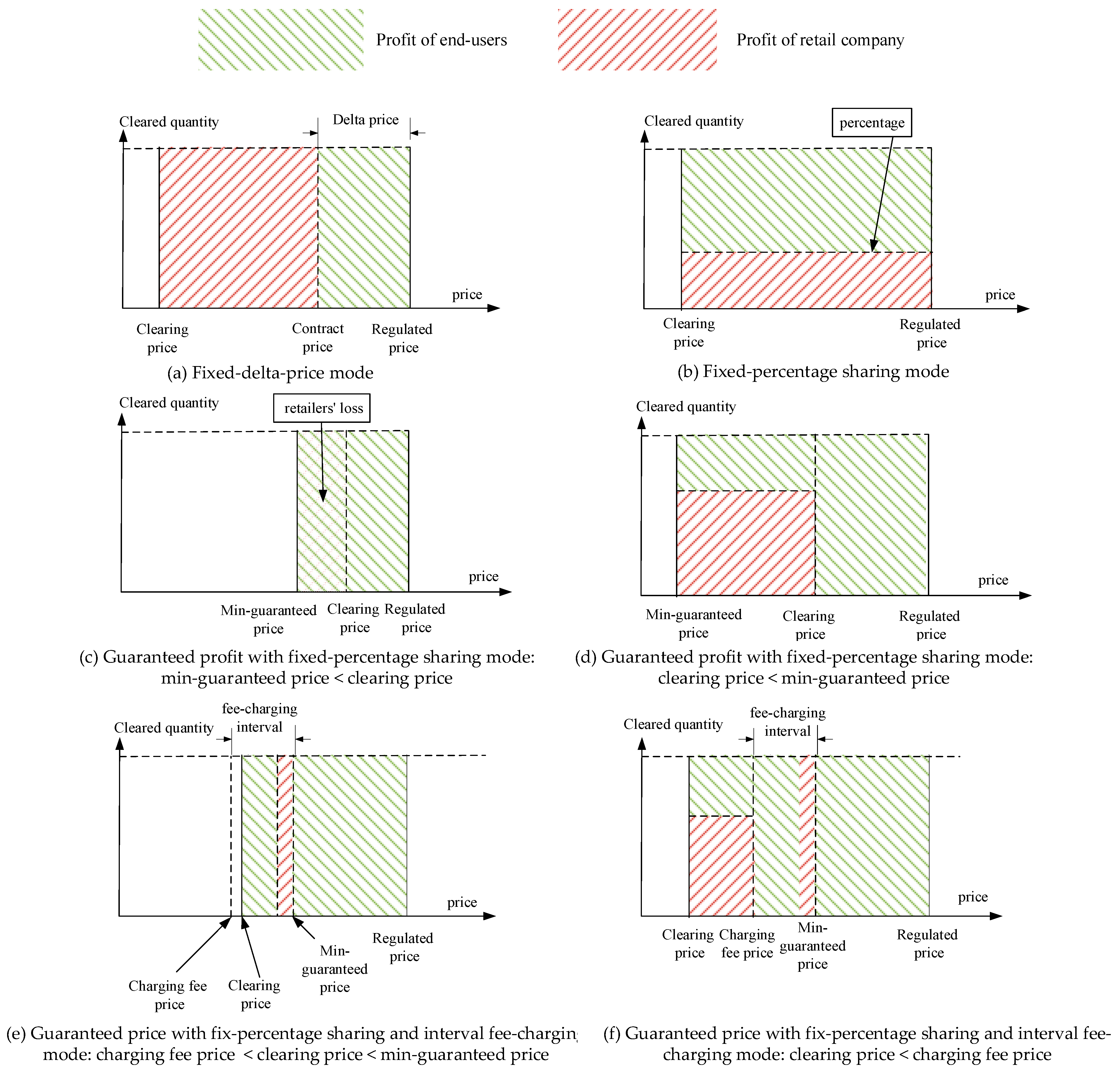
4. MRL-Based Electricity Market Simulation Model
4.1. MRL-Based Electricity Market Simulation
4.2. Reinforcement Learning-Based Modeling of the Retail Company
5. Case Study
5.1. Case Settings and Data
5.2. Bidding Decisions with Diverse Bidding Models
- S29 and S24: The bidding results of S29 and S24 are presented in Figure 7e,h, respectively. The results show that S24 finally converges at 0.404 RMB/kWh and S29 finally converges at 0.398 RMB/kWh. S29′s objective is to maximize profit, and thus, it bids a comparatively lower price to reduce the cost. At the same time, the prices bid by S29 in most rounds are almost equal to the clearing prices because the agent tends to guarantee it can be cleared. Different from S29, S24’s bidding eventually converges to 0.404 RMB/kWh, which is consistently higher than the market clearing price, which allows the electricity to be successfully cleared with a high probability.
- When observing the bids in different rounds, both S24 and S29 converge within 300 rounds of learning, showing fast convergencies compared to the other retail companies. The prices bid by S29 are highly different in the early rounds, i.e., some are very high and some are very low. After MRL training, S29 finally converges its bids at 0.398 RMB/kWh. The reason accounting for this result is that the expected profit of S29 is 2 million RMB, and the final bidding price around the marginal price can lead to reaching such an objective. As for S24, it does not bid low prices to avoid bidding failure.
- S17 and S18: The bidding results of S17 and S18 are presented in Figure 7a,b, respectively. Since the main objective of S17 is to defeat S18, the bidding prices of S17 are always a little higher than the bidding prices of S18. As for the bidding process, S17 explores less space because it does not need to try the low price.
- S27 and S28: The bidding results of S27 and S28 are presented in Figure 7f,g, respectively. The results show that S27 converges rapidly to 0.400 RMB/kWh, while S28 converges to two prices, i.e., 0.400 RMB/kWh and 0.42 RMB/kWh, while the former is the same as S27 and has a larger probability. Both S27 and S28 aim to expand the market in kWh, and their profit-sharing modes are the same as the fixed-delta-price mode. The only difference between S27 and S28 in the case settings is that they have different profit expectations. Specifically, S27 has a minimum profit expectation of 2 million RMB, while S28 would rather expand on the market by sacrificing a maximum loss of 2 million RMB. As a result, the bidding decisions of S28 converge to a higher price with a small probability.
- S19, S21, and S29: The bidding results of S19, S21, and S29 are presented in Figure 7c,d,h, respectively. The results show that S19 converges rapidly to three prices, 0.406, 0.42, and 0.416 RMB/kWh; S21 converges to 0.416 RMB/kWh; and S29 converges to 0.398 RMB/kWh. The unique difference in the case settings of the three retail companies is the profit-sharing mode. Their objectives are to maximize the profit, and the different profit-sharing modes lead to differences in the bidding decisions. S29 converges to 0.398 RMB/kWh around the market clearing price. It does not need to guarantee the minimum profit for the end users, and the total profit will be fully shared between the retail companies and the end users. In another sentence, the greater the total profit, the greater the profit of the power retail companies. As a result, it prefers to bid a lower price for higher profit. Different from S29, S19, and S21 guarantee the end users a trading price, and their profits mainly depend on the profit, excluding the guaranteed part and service fee. Therefore, they have little motivation to venture to bid a low price, which may lead to bidding failures, and tend to take a stable bidding strategy at a high bidding price. As a result, their bidding prices converge to approximately 0.406 RMB/kWh.
5.3. Market Clearing Results
6. Conclusions and Discussions
- Three types of operation objectives and five types of profit-sharing modes are mathematically formulated. Three types of operation objectives include maximizing profit, market expansion in kWh or RMB, and defeating the opponent. Five types of profit-sharing modes include fixed-delta-price, fixed-percentage sharing, guaranteed price with a fixed percentage, service fee, and guaranteed price with fixed-percentage sharing and interval fee-charging modes.
- The proposed models can effectively reflect the differences in the bidding decisions regarding their objectives and profit-sharing modes, which can finally lead to different bidding prices. In detail, retail companies with diverse bidding decision-making will have differences in the action space and converged pricing. Retail companies with the objective of maximizing profit will tend to bid lower prices, while those with the objective of maximizing market share will tend to bid higher prices. Comparing the results of different profit-sharing modes, the ones with guaranteed prices or service-fee modes tend to bid higher prices, while the ones with fixed-percentage modes are inclined to bid lower prices. In addition, the ones with higher profit expectations will bid higher prices. Moreover, due to the complicated system with multiple agents and diverse bidding models, the equilibrium conditions become complex. Some retailers tend to converge on several different bidding decisions, especially when these decisions will not largely influence their values of the objective functions.
- A complete MRL-based electricity market simulation model is established, and simulation research is carried out in this paper. The case is well-designed to compare the impacts of one-by-one parameters of the retail companies while keeping the market environment exactly the same. Simulation results show that the internal competition among retail companies after MRL is more intense and will lead to an increase in market clearing prices. When the demand quantity from the retail companies is less than the offer quantity from the generation companies, the market clearing quantity tends to increase after MRL, showing positive effects for the agents.
Author Contributions
Funding
Institutional Review Board Statement
Informed Consent Statement
Data Availability Statement
Conflicts of Interest
Appendix A
| Type | Per kWh Price (Yuan/kWh) | |||||||
|---|---|---|---|---|---|---|---|---|
| <1 kV | 1–10 kV | 35 kV | 110 kV | 220 kV | ||||
| Residential end users | Normal time | 0.5953 | -- | -- | -- | -- | ||
| Valley time | 0.3153 | -- | -- | -- | -- | |||
| Industrial or commercial end users | (plan A: pay as you go) | Peak time | July, August, September | 1.1739 | 1.1494 | 1.1250 | -- | -- |
| Other | 1.1053 | 1.0823 | 1.0594 | -- | -- | |||
| Normal time | 0.7416 | 0.7266 | 0.7116 | -- | -- | |||
| Valley time | 0.4603 | 0.4514 | 0.4426 | -- | -- | |||
| (plan B: package) | Peak time | July, August, September | -- | 1.0181 | 0.9936 | 0.9692 | 0.9529 | |
| NO. | Self Study | Power Needm (GWh) | Operation Objective | Profit-Sharing Mode | Sharing Percentage | Profit(+)/ Loss(-) Goal (Million RMB) | Fixed-Delta-Price (RMB/kWh) | Guaranteed Price (RMB/kWh) | Recency Factor (R) | Empirical Factor (E) | Service Fee (RMB/kWh) |
|---|---|---|---|---|---|---|---|---|---|---|---|
| S1–S10 | No | 20 | - | - | - | - | - | - | - | - | - |
| S11 | No | 60 | Max profit | Fixed percentage | 0.1 | - | - | - | - | - | - |
| S12 | No | 50 | Max profit | Fixed percentage | 0.1 | - | - | - | - | - | - |
| S13 | No | 100 | Market expansion in kWh | Fixed-delta-price | - | - | - | - | - | - | - |
| S14 | No | 110 | Market expansion in kWh | Fixed percentage | 0.5 | - | - | - | - | - | - |
| S15 | No | 70 | Market expansion in RMB | Fixed percentage | 0.5 | - | - | - | - | - | - |
| S16 | No | 70 | Market expansion in RMB | Fixed-delta-price | - | - | - | - | - | - | - |
| S17 | No | 50 | Defeat opponent (S18) | Fixed percentage | 0.5 | - | - | - | - | - | - |
| S18 | Yes | 70 | Max profit | Fixed percentage | 0.5 | +5 | - | - | 0.02 | 0.02 | - |
| S19 | Yes | 75 | Max profit | Hybrid: fixed-delta-price and fixed percentage | 0.1 | - | - | 0.39 | 0.02 | 0.02 | - |
| S20 | Yes | 71 | Max profit | Hybrid: fixed percentage and service fee | 0.5 | - | - | 0.39 | 0.02 | 0.02 | 0.12 |
| S21 | Yes | 73 | Max profit | Guaranteed price with a fixed percentage sharing and interval fee-charging | 0.1 | - | - | 0.4 | 0.02 | 0.02 | 0.12 |
| S22 | Yes | 71 | Max profit | Guaranteed price with a fixed percentage | 0.1 | - | - | 0.45 | 0.02 | 0.02 | - |
| S23 | Yes | 73 | Max profit | Fixed percentage | 0.5 | +2 | - | - | 0.1 | 0.02 | - |
| S24 | Yes | 120 | Market expansion in kWh | Fixed-delta-price | - | - | 0.02 | - | 0.02 | 0.02 | - |
| S25 | Yes | 130 | Market expansion in kWh | Fixed-delta-price | - | -54.9 | 0.02 | - | 0.02 | 0.02 | - |
| S26 | Yes | 110 | Market expansion in kWh | Fixed-delta-price | - | -44 | 0.02 | - | 0.02 | 0.02 | - |
| S27 | Yes | 71 | Market expansion in RMB | Fixed-delta-price | - | +2 | 0.02 | - | 0.02 | 0.02 | - |
| S28 | Yes | 71 | Market expansion in RMB | Fixed-delta-price | - | -2 | 0.07 | - | 0.02 | 0.02 | - |
| S29 | Yes | 70 | Max profit in RMB | Fixed percentage | 0.1 | +2 | - | - | 0.02 | 0.02 | - |
| S30 | Yes | 130 | Max profit in RMB | Fixed percentage | 0.5 | +2 | - | - | 0.02 | 0.02 | - |
References
- Guo, H.; Davidson, M.R.; Chen, Q.; Zhang, D.; Jiang, N.; Xia, Q.; Kang, C.; Zhang, X. Power market reform in China: Motivations, progress, and recommendations. Energy Policy 2020, 145, 111717. [Google Scholar] [CrossRef]
- Zheng, X.; Menezes, F.; Nepal, R. In between the state and the market: An empirical assessment of the early achievements of China's 2015 electricity reform. Energy Econ. 2021, 93, 105003. [Google Scholar] [CrossRef]
- Jain, K.; Saxena, A.; Alshamrani, A.M.; Alrasheedi, A.F.; Alnowibet, K.A.; Mohamed, A.W. An amended whale optimization algorithm for optimal bidding in day ahead electricity market. Axioms 2022, 11, 456. [Google Scholar] [CrossRef]
- Richter, J.; Viehmann, J. The value of information in explicit crossborder capacity auction regimes in electricity markets. Energy Policy 2014, 70, 74–84. [Google Scholar] [CrossRef]
- Wu, H.; Liu, X.; Ye, B.; Xu, B. Optimal dispatch and bidding strategy of a virtual power plant based on a Stackelberg game. IET Gener. Transm. Distrib. 2020, 14, 552–563. [Google Scholar] [CrossRef]
- Kang, D.-J.; Kim, B.H.; Hur, D. Supplier bidding strategy based on non-cooperative game theory concepts in single auction power pools. Electric Power Syst. Res. 2007, 77, 630–636. [Google Scholar] [CrossRef]
- Zhao, F.; Luh, P.B.; Yan, J.H.; Stern, G.A.; Chang, S.C. Bid Cost Minimization Versus Payment Cost Minimization: A Game Theoretic Study of Electricity Auctions. IEEE Trans. Power Syst. 2010, 25, 181–194. [Google Scholar] [CrossRef]
- Wang, S.; Li, J.; Du, P.; Zhao, E. A game theoretic technique for risk-based optimal bidding strategies in energy aggregators of markets: Knowledge management approach. J. Innov. Knowl. 2022, 7, 100279. [Google Scholar] [CrossRef]
- Saeian, H.; Niknam, T.; Zare, M.; Aghaei, J. Coordinated optimal bidding strategies methods of aggregated microgrids: A game theory-based demand side management under an electricity market environment. Energy 2022, 245, 123205. [Google Scholar] [CrossRef]
- Peng, X.; Tao, X. Cooperative game of electricity retailers in China's spot electricity market. Energy 2018, 145, 152–170. [Google Scholar] [CrossRef]
- Zugno, M.; Morales, J.M.; Pinson, P.; Madsen, H. Pool strategy of a price-maker wind power producer. IEEE Trans. Power Syst. 2013, 28, 3440–3450. [Google Scholar] [CrossRef]
- Jiang, T.; Yuan, C.; Bai, L.; Chowdhury, B.; Zhang, R.; Li, X. Bi-level strategic bidding model of gas-fired units in interdependent electricity and natural gas markets. IEEE Trans. Sustain. Energy 2022, 13, 328–340. [Google Scholar] [CrossRef]
- Boyd, S.; Boyd, S.P.; Vandenberghe, L. Convex Optimization; Cambridge University Press: Cambridge, UK, 2004; Volume 51, p. 1859. [Google Scholar]
- Esmaeili Aliabadi, D.; Kaya, M.; Sahin, G. Competition, risk and learning in electricity markets: An agent-based simulation study. Appl. Energy 2017, 195, 1000–1011. [Google Scholar] [CrossRef]
- Xu, S.; Rahman, S.; Xie, J.; Chen, X. Agent-based modeling and simulation of the electricity market with residential demand response. CSEE J. Power Energy Syst. 2020, 7, 368–380. [Google Scholar]
- North, M.; Macal, C.; Conzelmann, G.; Koritarov, V.; Thimmapuram, P.; Veselka, T. Multi-Agent Electricity Market Modeling with EMCAS (No. ANL/DIS/CP-108599); Argonne National Laboratory: Argonne, IL, USA, 2002. Available online: https://www.osti.gov/servlets/purl/801575 (accessed on 20 December 2022).
- Samaan, N.A. Deploying Intra-Hour Uncertainty Analysis Tools to ABB’s GridView-CRADA 445 (No. PNNL-SA-160084); Pacific Northwest National Laboratory (PNNL): Richland, WA, USA, 2021. [Google Scholar] [CrossRef]
- Sun, J.; Tesfatsion, L. Dynamic testing of wholesale electricity market designs: An open-source agent-based framework. Comput. Econ. 2007, 30, 291–327. [Google Scholar] [CrossRef]
- Thomas, R.J.; Mount, T.D.; Zimmerman, R.D. PowerWeb testing of various auction clearing mechanisms for electricity. In Proceedings of the IEEE PES Power Systems Conference and Exposition, New York, NY, USA, 10–13 October 2004; Institute of Electrical and Electronics Engineers: Piscataway, NJ, USA, 2004; pp. 1624–1630. [Google Scholar] [CrossRef]
- Feng, H.; Yang, Z.L.; Zheng, Y.X.; Ye, F.; Zhang, X.; Shi, X. Intelligent Agent Based Bidding Simulation Method for Multi input Decision Factors of Power Suppliers. Autom. Electr. Power Syst. 2018, 42, 72–77. [Google Scholar] [CrossRef] [PubMed]
- Erev, I.; Roth, A.E. Predicting how people play games: Reinforcement learning in experimental games with unique, mixed strategy equilibria. Am. Econ. Rev. 1998, 88, 848–881. [Google Scholar]
- Watkins, C.J.; Dayan, P. Q-learning. Mach. Learn. 1992, 8, 279–292. [Google Scholar] [CrossRef]
- Kiran, P.; Chandrakala, K.V. New interactive agent based reinforcement learning approach towards smart generator bidding in electricity market with micro grid integration. Appl. Soft Comput. 2020, 97, 106762. [Google Scholar] [CrossRef]
- Jiang, Z.; Ai, Q. Agent-based simulation for symmetric electricity market considering price-based demand response. J. Mod. Power Syst. Clean Energy 2017, 5, 810–819. [Google Scholar] [CrossRef]
- Purushothaman, K.; Chandrakala, V. Roth-Erev reinforcement learning approach for smart generator bidding towards long term electricity market operation using agent based dynamic modeling. Electr. Power Compon. Syst. 2020, 48, 256–267. [Google Scholar] [CrossRef]
- Zhou, Z.; Zhao, F.; Wang, J. Agent-based electricity market simulation with demand response from commercial buildings. IEEE Trans. Smart Grid 2011, 2, 580–588. [Google Scholar] [CrossRef]
- Ali, G.G.; El-adaway, I.H.; Sims, C.; Holladay, J.S.; Chen, C.-F. Studying dynamic pricing in electrical power markets with distributed generation: Agent-based modeling and reinforcement-learning approach. J. Energy Eng. 2022, 148, 04022030. [Google Scholar] [CrossRef]
- Rashedi, N.; Tajeddini, M.A.; Kebriaei, H. Markov game approach for multi-agent competitive bidding strategies in electricity market. IET Gener. Transm. Distrib. 2016, 10, 3756–3763. [Google Scholar] [CrossRef]
- Farshad, M. Distributed generation planning from the investor's viewpoint considering pool-based electricity markets. Electr. Power Syst. Res. 2020, 187, 106474. [Google Scholar] [CrossRef]
- Namalomba, E.; Feihu, H.; Shi, H. Agent based simulation of centralized electricity transaction market using bi-level and Q-learning algorithm approach. Int. J. Electr. Power Energy Syst. 2022, 134, 107415. [Google Scholar] [CrossRef]
- Liang, Y.; Guo, C.; Ding, Z.; Hua, H. Agent-based modeling in electricity market using deep deterministic policy gradient algorithm. IEEE Trans. Power Syst. 2020, 35, 4180–4192. [Google Scholar] [CrossRef]
- Ye, Y.; Qiu, D.; Sun, M.; Papadaskalopoulos, D.; Strbac, G. Deep reinforcement learning for strategic bidding in electricity markets. IEEE Trans. Smart Grid 2019, 11, 1343–1355. [Google Scholar] [CrossRef]
- Esmaeili Aliabadi, D.; Chan, K. The emerging threat of artificial intelligence on competition in liberalized electricity markets: A deep Q-network approach. Appl. Energy 2022, 325, 119813. [Google Scholar] [CrossRef]
- Wu, J.; Wang, J.; Kong, X. Strategic bidding in a competitive electricity market: An intelligent method using multi-agent transfer learning based on reinforcement learning. Energy 2022, 256, 124657. [Google Scholar] [CrossRef]
- Jia, S.; Gan, Z.; Xi, Y.; Li, D.; Xue, S.; Wang, L. A deep reinforcement learning bidding algorithm on Electricity Market. J. Therm. Sci. 2020, 29, 1125–1134. [Google Scholar] [CrossRef]
- Du, Y.; Li, F.; Zandi, H.; Xue, Y. Approximating Nash equilibrium in day-ahead electricity market bidding with multi-agent deep reinforcement learning. J. Mod. Power Syst. Clean Energy 2021, 9, 534–544. [Google Scholar] [CrossRef]
- Guangdong Power Exchange Center CO, LTD. Annual Report of Guangdong Electricity Market in 2021. Available online: https://pm.gd.csg.cn/views/page/downfile/infoAdmin/info/20220208171001/%E5%B9%BF%E4%B8%9C%E7%94%B5%E5%8A%9B%E5%B8%82%E5%9C%BA2021%E5%B9%B4%E5%B9%B4%E5%BA%A6%E6%8A%A5%E5%91%8A20220208171419.pdf (accessed on 25 January 2023).
- Dou, X.; Zhang, P.; Li, J.A.; Wang, J. Analysis of power purchase-sale strategy of power retail companies with different establishment qualifications. Proc. CSEE 2020, 40, 181–188. [Google Scholar]
- Jiang, L.; Liu, S.Q.; Li, J.C.; Ye, Z. Research on influencing factors of profitability of electricity sales companies under spread rebate mode. Price Theory Pract. 2020, 3, 147–150. [Google Scholar]
- China’s National Energy Administration. Say Goodbye to Disorderly Competition Power Market Calls for an Era of Power Sales Specialization. Available online: http://www.nea.gov.cn/2017-11/03/c_136725792.htm (accessed on 20 January 2023).
- China Weekly. Chaos of Electricity Retail Reform. Available online: http://www.inewsweek.cn/finance/2021-08-21/13546.shtml (accessed on 20 January 2023).
- Wang, X.; Liu, W.; Liang, G.; Zhao, J.; Qiu, J. Lessons learned from power industry reform and electricity spot market trial operation in Southern China. Energy Clim. Change 2021, 2, 100055. [Google Scholar] [CrossRef]
- Lu, T.; Zhang, W.; Wang, Y.; Xie, H.; Ding, X. Medium- and long-term trading strategies for large electricity retailers in China’s electricity market. Energies 2022, 15, 3342. [Google Scholar] [CrossRef]
- Lu, T.; Chen, X.; McElroy, M.B.; Nielsen, C.P.; Wu, Q.; Ai, Q. A Reinforcement Learning-Based Decision System for Electricity Pricing Plan Selection by Smart Grid End Users. IEEE Trans. Smart Grid 2021, 12, 2176–2187. [Google Scholar] [CrossRef]
- Zhang, Z.; Jiang, Y.; Lin, Z.; Wen, F.; Ding, Y.; Yang, L.; Lin, Z.; Li, Y.; Qian, H.; Li, J.; et al. Optimal Alliance Strategies Among Retailers Under Energy Deviation Settlement Mechanism in China's Forward Electricity Market. IEEE Trans. Power Syst. 2020, 35, 2059–2071. [Google Scholar] [CrossRef]
- Wang, Y.; Zhang, L.; Ding, Q.; Zhang, K. Prospect theory-based optimal bidding model of a prosumer in the power market. IEEE Access 2020, 8, 137063–137073. [Google Scholar] [CrossRef]
- AEMO Energy Offers (Public). Available online: https://www.aemo.com.au/energy-systems/electricity/national-electricity-market-nem/data-nem/market-data-nemweb (accessed on 22 January 2023).
- PJM Manual 11: Energy & Ancillary Services Market Operations. Available online: http://www.pjm.com/~/media/documents/manuals/m11.ashx (accessed on 15 December 2022).
- Son, Y.S.; Baldick, R.; Lee, K.H.; Siddiqi, S. Short-term electricity market auction game analysis: Uniform and pay-as-bid pricing. IEEE Trans. Power Syst. 2004, 19, 1990–1998. [Google Scholar] [CrossRef]
- Cramton, P.; Stoft, S. Why we need to stick with uniform-price auctions in electricity markets. Electr. J. 2007, 20, 26–37. [Google Scholar] [CrossRef]
- Independent System Operator New England. The Benefits of Uniform Clearing-Price Auctions for Pricing Electricity: Why Pay-as-Bid Auctions Do Not Cost Less. ISONE Report 2006. Available online: https://www.iso-ne.com/static-assets/documents/committees/comm_wkgrps/othr/clg/mtrls/2009/jul292009/uniform_clearing_price_auctions_whitepaper.pdf (accessed on 15 December 2022).
- Liu, T.; Xu, J. Equilibrium strategy based policy shifts towards the integration of wind power in spot electricity markets: A perspective from China. Energy Policy 2021, 157, 112482. [Google Scholar] [CrossRef]
- Wang, Y.; Wang, D.; Zhang, H.; Zhang, K. Optimal bidding of price-maker retailers with demand price quota curves under price uncertainty. IEEE Access 2020, 8, 120746–120756. [Google Scholar] [CrossRef]
- Wang, Y.; Tian, L.; Xia, J.; Zhang, W.; Zhang, K. Economic Assessment of the Peer-to-Peer Trading Policy of Distributed PV Electricity: A Case Study in China. Sustainability 2020, 12, 5235. [Google Scholar] [CrossRef]
- Guangdong Power Exchange Center. Monthly Trading Data 2022. Available online: https://pm.gd.csg.cn/views/page/market.html (accessed on 20 January 2023).
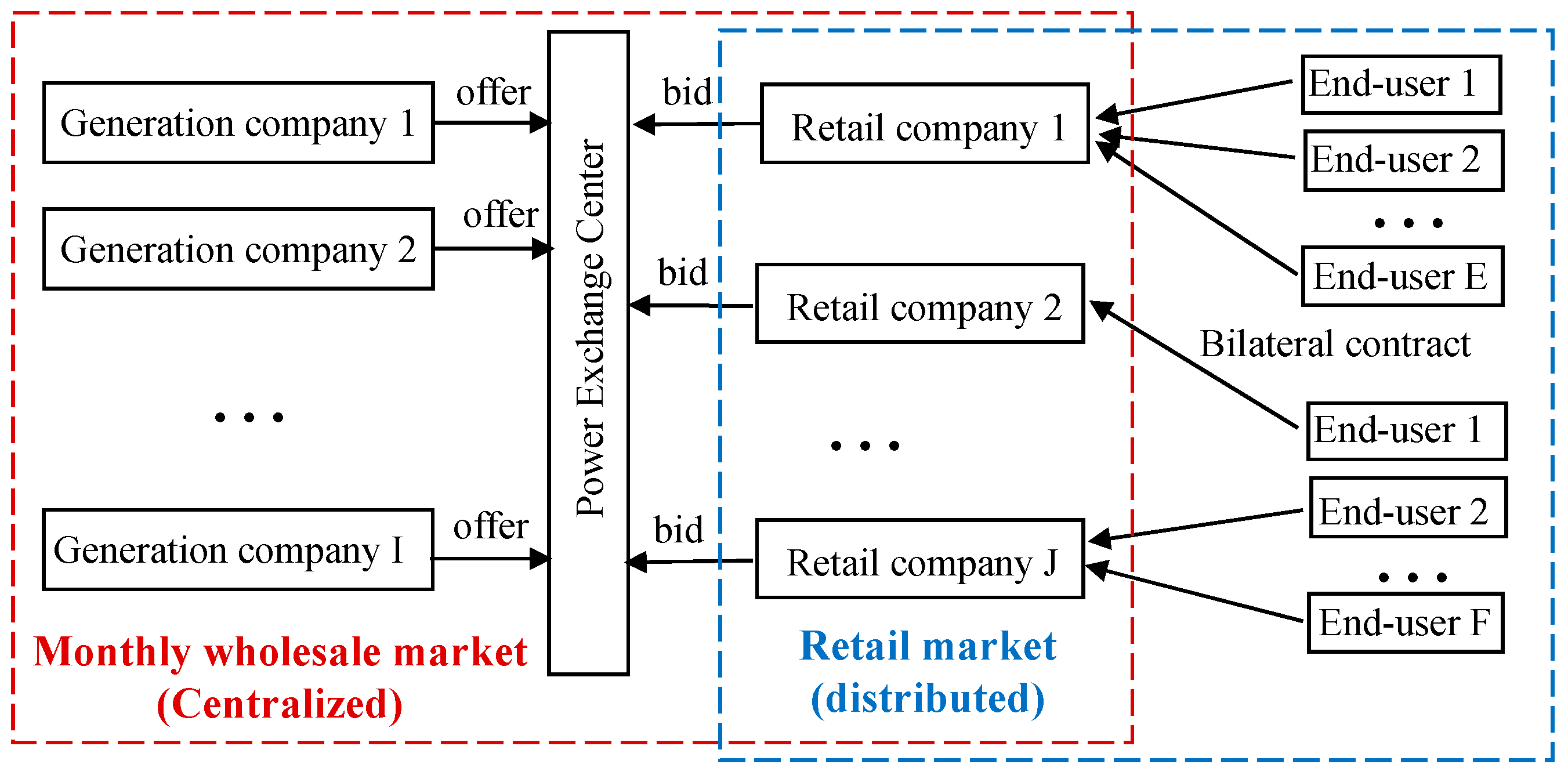

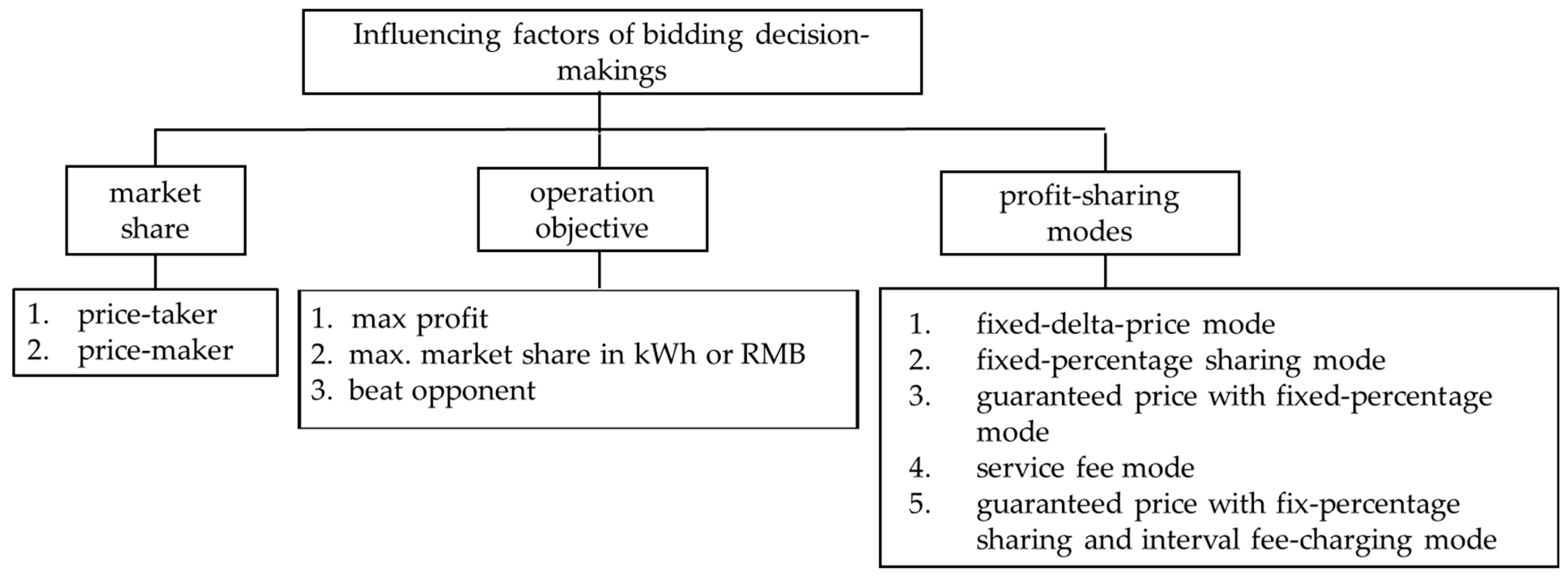
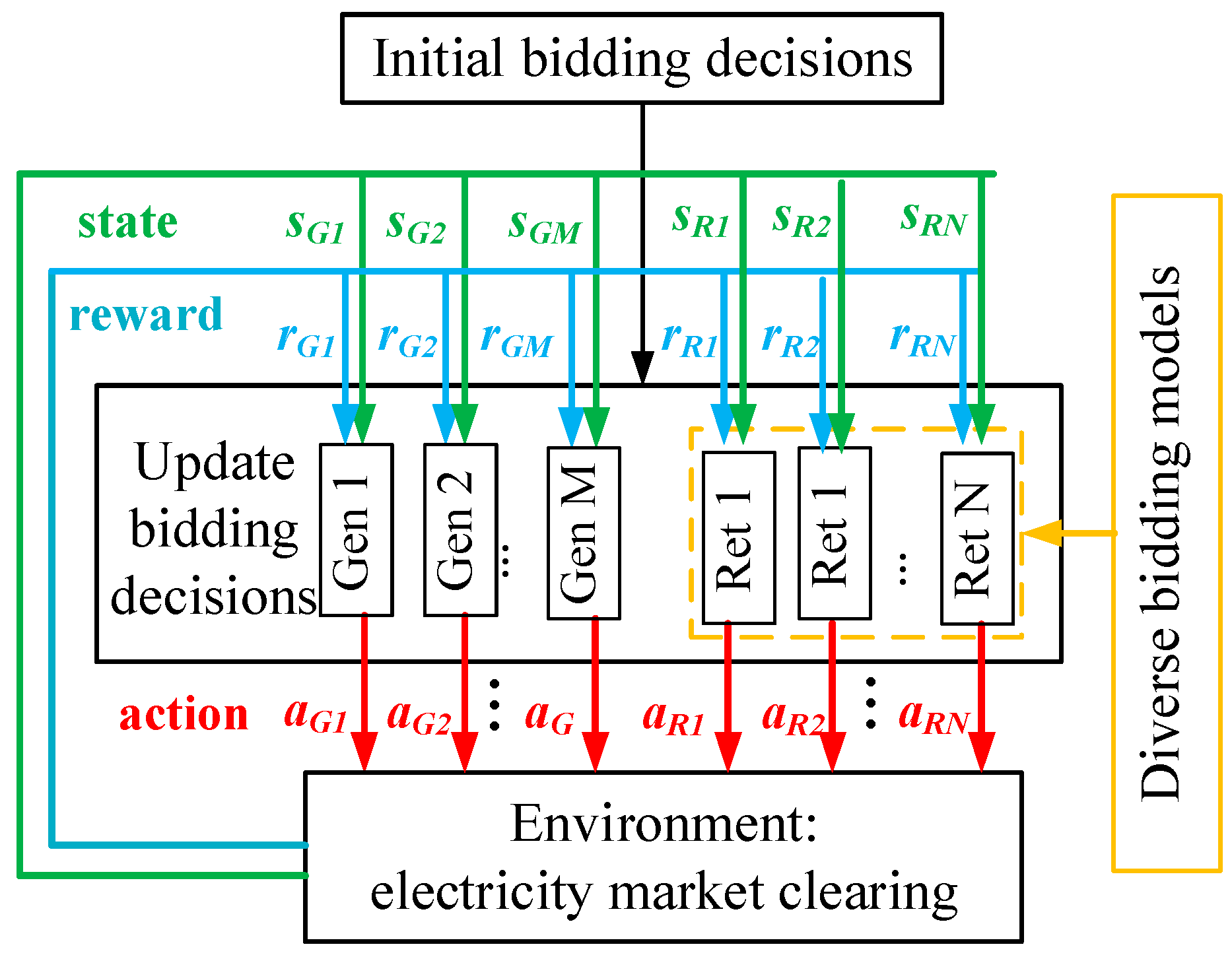
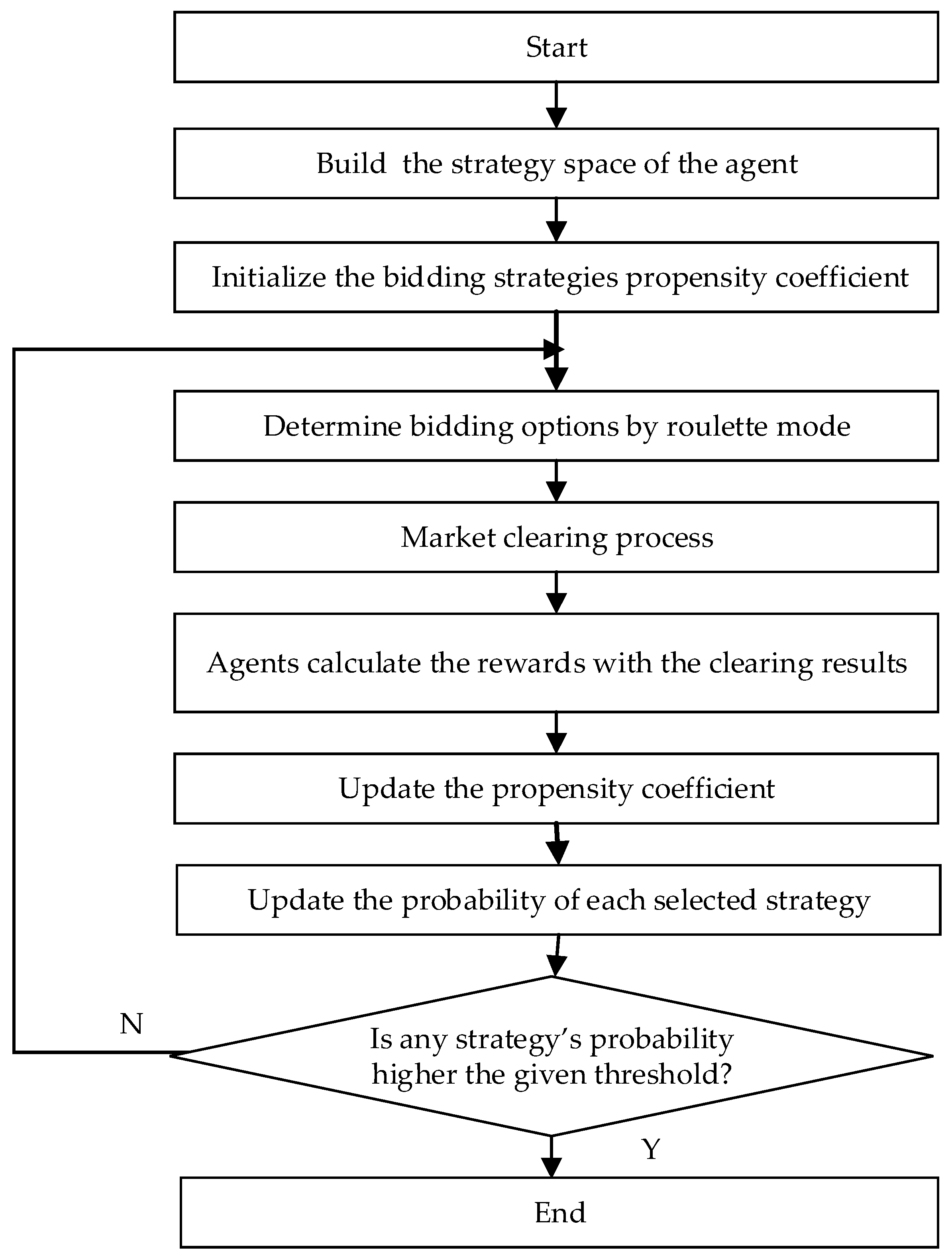

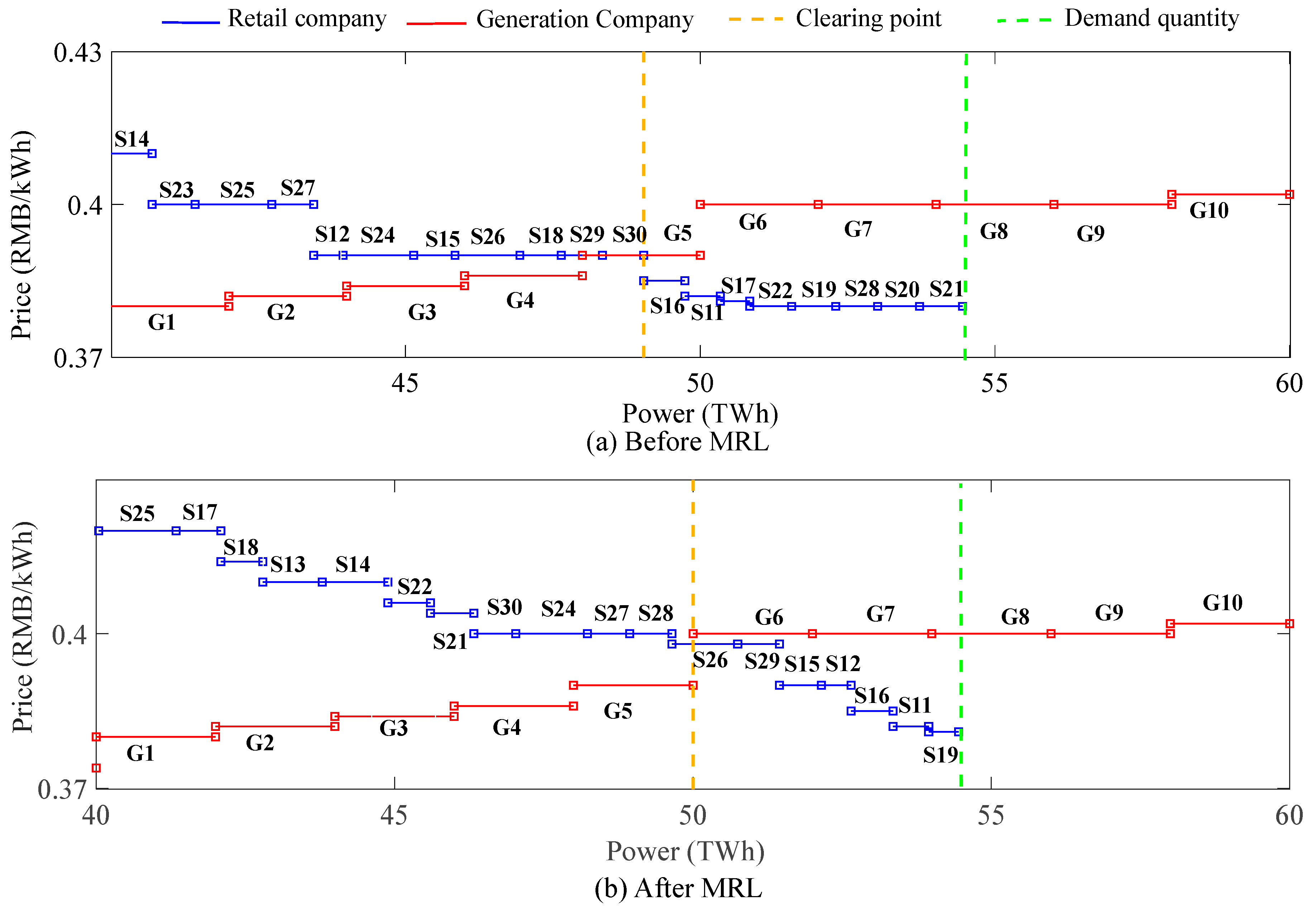
| Example | Differences | Results | ||
|---|---|---|---|---|
| Bidding Results | Convergence Price (RMB/kWh) | |||
| 1 | Different operation objectives | S29: max profit | Figure 7h | S29: 0.398 |
| S24: maximize market share in kWh | Figure 7e | S24: 0.404 | ||
| 2 | Different operation objectives | S17: defeat opponent S18 | Figure 7a | S17: 0.398 |
| S18: max profit | Figure 7b | S18: 0.424 | ||
| 3 | Different profit objectives | S27: fixed-delta-price: goal price + 0.02 RMB/kWh | Figure 7f | S27: 0.414 |
| S28: fixed-delta-price: goal price − 0.02 RMB/kWh | Figure 7g | S28: 0.400/0.42 | ||
| 4 | Different profit-sharing mode | S21: guaranteed price with a fixed-percentage sharing and interval fee-charging | Figure 7d | S21: 0.416 |
| S19: guaranteed price a with fixed-percentage sharing mode | Figure 7c | S19: 0.406/0.42/0.416 | ||
| S29: fixed-percentage sharing | Figure 7h | S29: 0.398 | ||
Disclaimer/Publisher’s Note: The statements, opinions and data contained in all publications are solely those of the individual author(s) and contributor(s) and not of MDPI and/or the editor(s). MDPI and/or the editor(s) disclaim responsibility for any injury to people or property resulting from any ideas, methods, instructions or products referred to in the content. |
© 2023 by the authors. Licensee MDPI, Basel, Switzerland. This article is an open access article distributed under the terms and conditions of the Creative Commons Attribution (CC BY) license (https://creativecommons.org/licenses/by/4.0/).
Share and Cite
Wang, Y.; Liu, C.; Yuan, W.; Li, L. MRL-Based Model for Diverse Bidding Decision-Makings of Power Retail Company in the Wholesale Electricity Market of China. Axioms 2023, 12, 142. https://doi.org/10.3390/axioms12020142
Wang Y, Liu C, Yuan W, Li L. MRL-Based Model for Diverse Bidding Decision-Makings of Power Retail Company in the Wholesale Electricity Market of China. Axioms. 2023; 12(2):142. https://doi.org/10.3390/axioms12020142
Chicago/Turabian StyleWang, Ying, Chang Liu, Weihong Yuan, and Lili Li. 2023. "MRL-Based Model for Diverse Bidding Decision-Makings of Power Retail Company in the Wholesale Electricity Market of China" Axioms 12, no. 2: 142. https://doi.org/10.3390/axioms12020142
APA StyleWang, Y., Liu, C., Yuan, W., & Li, L. (2023). MRL-Based Model for Diverse Bidding Decision-Makings of Power Retail Company in the Wholesale Electricity Market of China. Axioms, 12(2), 142. https://doi.org/10.3390/axioms12020142






